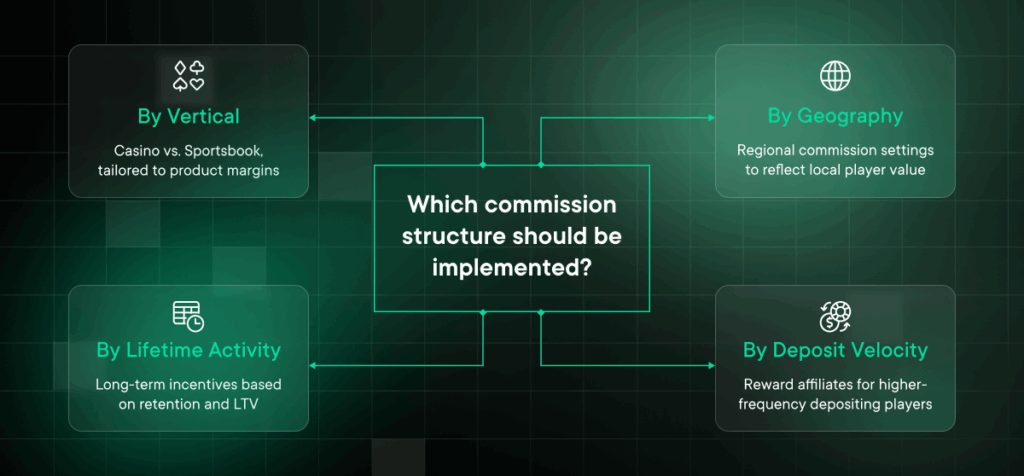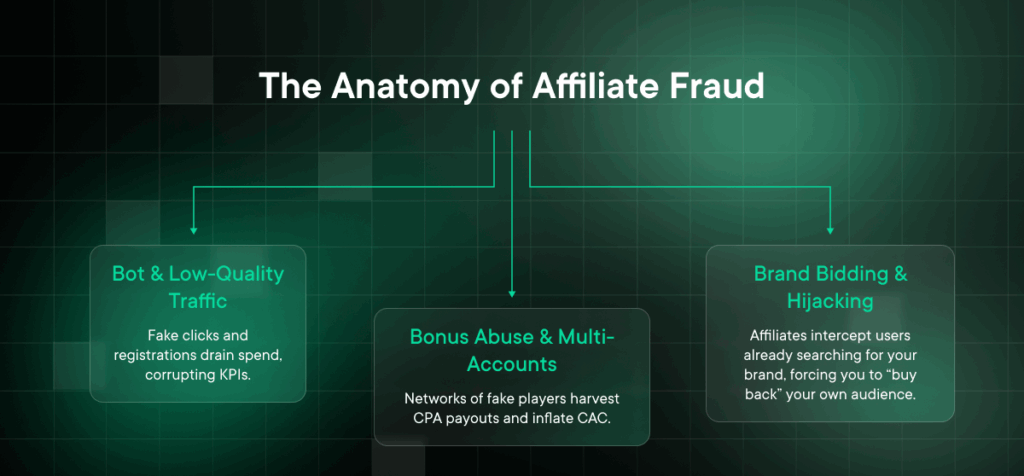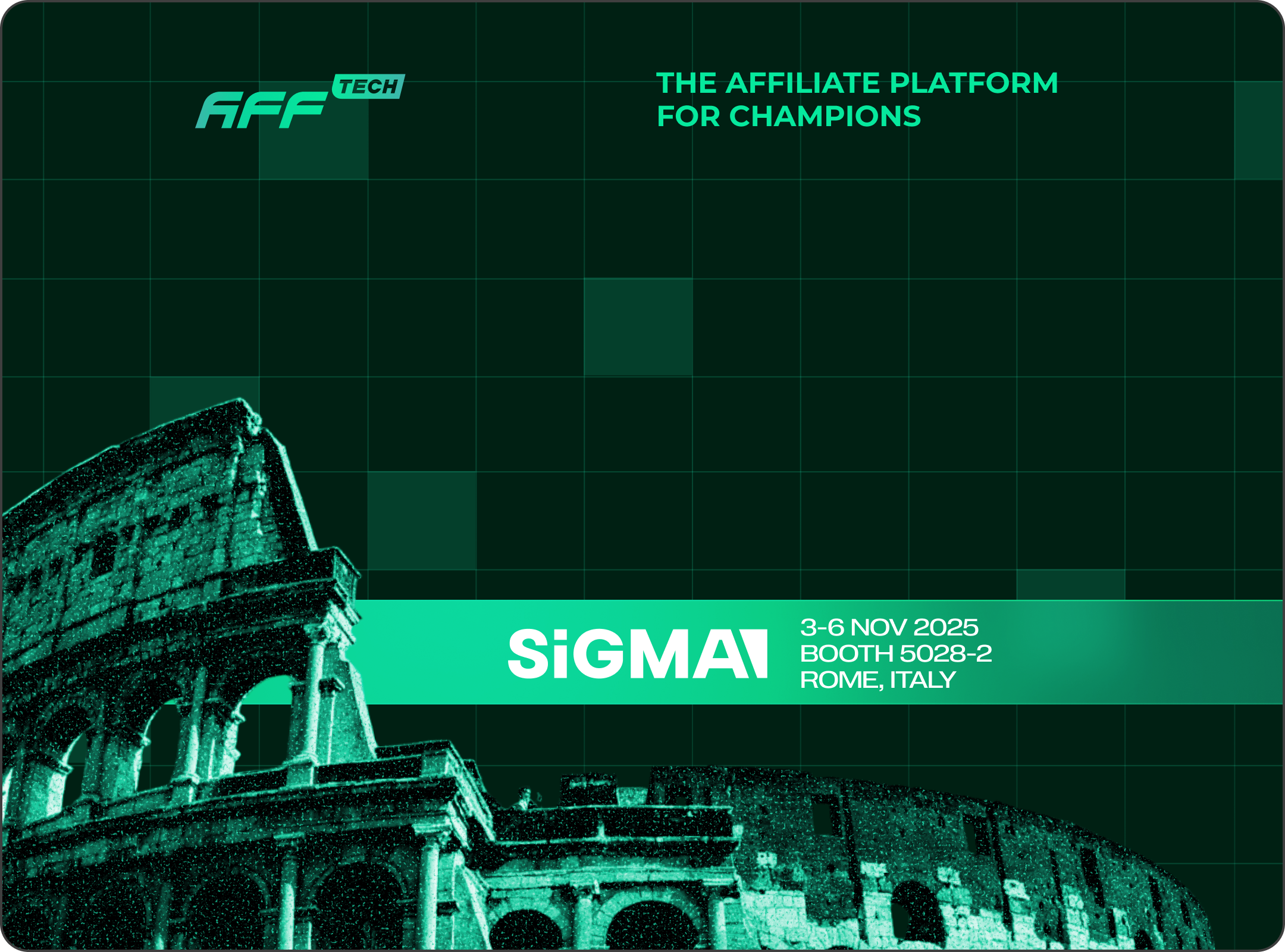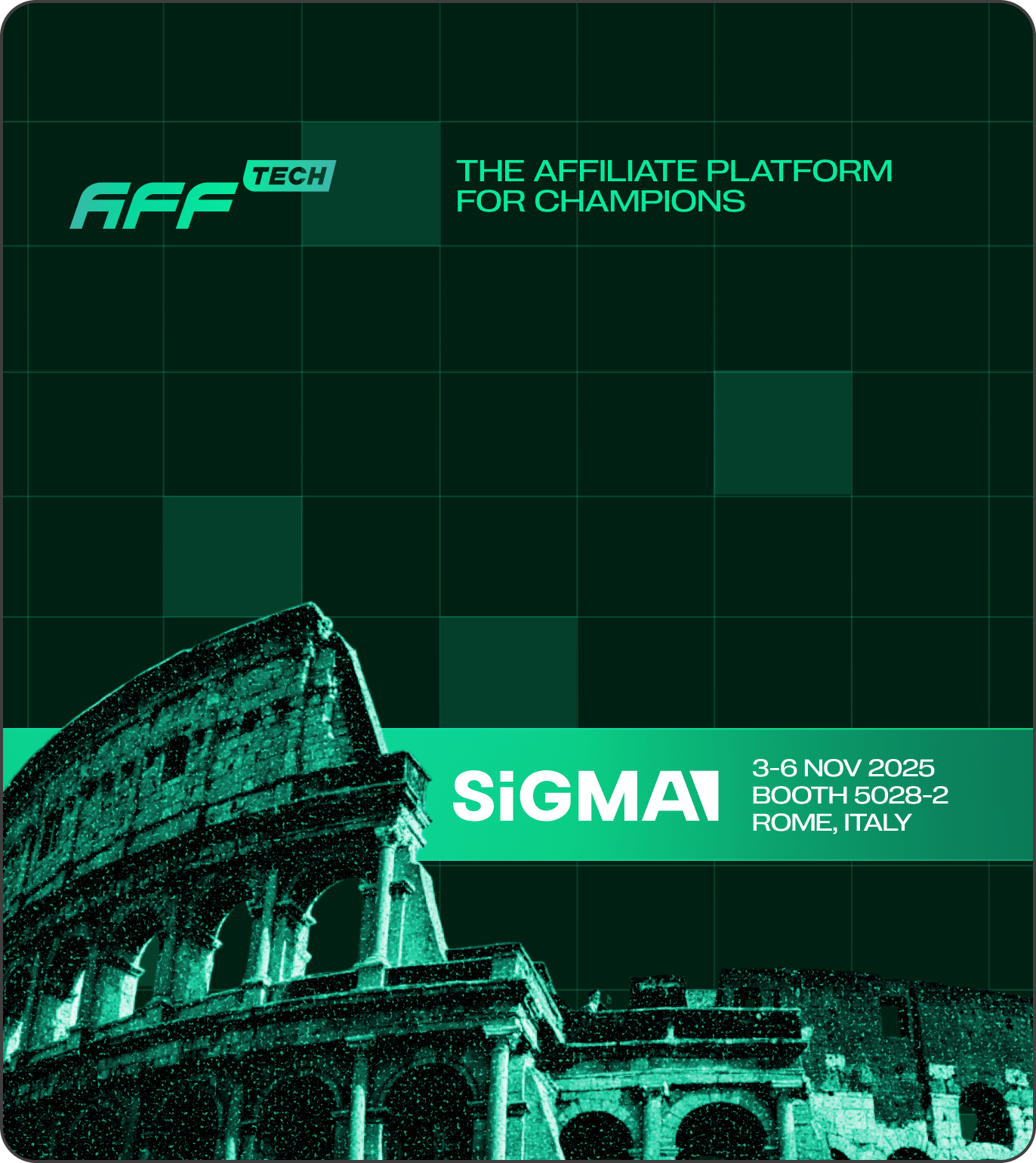
How iGaming Operators Can Use Affiliate Software to Boost Player Acquisition and Retention
The central trade-off in affiliate marketing remains unchanged over the years: operators continue to surrender margin control and accept fraud risk in exchange for increased volume without upfront spending. But the tooling that governs this exchange has shifted dramatically; instead of just tracking clicks and payouts, modern affiliate software for iGaming operators compresses months of manual work into completely automated pipelines.
The role of the affiliate has also evolved; yesterday’s simple referral partners have turned into sophisticated “content creators,” “brand storytellers,” and “data-driven marketing experts” who are now essentially in charge of shaping engagement for iGaming platforms (affiliate channels account for at least 60% of new player registrations across licensed markets).
In this equation, the question of how iGaming operators can use affiliate marketing software to bring in more players as well as keep them engaged over the long term becomes central. In answering it, we’ll go over how affiliate tools help optimize campaigns, track performance in real time, and use data to cut waste while boosting ROI. By the time you’re done reading, you’ll understand how to structure and manage affiliates more effectively, what best practices actually move the needle, and how modern affiliate software for iGaming can turn your acquisition channel into a reliable growth engine.
Player Acquisition With IGaming Affiliate Software
The affiliate appeal is structural: you pay only for qualified players, affiliates absorb creative and testing costs, and your brand reaches audiences you’d struggle to access through direct channels.
Dedicated affiliate software consolidates partner onboarding, link generation, conversion tracking, and payout approvals into a single workflow. Operators define commission structures (RevShare, CPA, hybrid) at the partner level, then let the platform handle attribution logic, deposit thresholds, and negative carryover rules. The result is that you shift from spreadsheet to dashboard, freeing your team to focus on partner recruitment and creative optimization rather than forensic accounting.
| Challenge | Core Problem | Affiliate Software Solution | Strategic Outcome |
| The Transparency Gap | Opaque calculations, payment disputes | Real-Time, Granular Reporting; Shared Dashboards | Rebuilds trust, eliminates disputes, creates data-driven partnerships. |
| Affiliate Fraud | Bonus abuse, bot traffic, brand bidding | Integrated Anti-Fraud Suite; Advanced Lead Qualification; Device Fingerprinting | Protects marketing ROI, improves traffic quality, ensures accurate attribution. |
| Regulatory Burden | Multi-jurisdiction compliance, responsible gaming | Automated Compliance Tools; Geo-fencing & KYC Triggers; Immutable Audit Logs | Mitigates legal and financial risk, ensures operational compliance at scale. |
| The Retention Conundrum | “Bonus hunters,” misaligned incentives | Flexible Commission Constructor; Post-Acquisition Tracking (LTV, NGR) | Aligns affiliate and operator goals toward acquiring high-LTV players. |
💡The mechanics matter here. A properly configured platform tracks every click through unique identifiers, passes that data via postback to your CRM or BI stack, and attributes conversions even when players switch devices or delay registration. Without this precision, you either overpay on duplicates or underpay on legitimate conversions, eroding both margin and iGaming partner trust.
Optimizing iGaming Affiliate Management Solutions
Optimization begins with segmentation. Not all affiliates deliver the same quality of players, and broad commission structures penalize high performers while subsidizing low-grade traffic. Modern platforms let operators tier commission rates by vertical (casino vs. sportsbook), geography, deposit velocity, and lifetime activity. An affiliate driving high-roller slots players in Germany earns a different rate than one delivering casual sports bettors in Brazil.
This granularity aligns incentives: partners chase the traffic you value most, and you pay for outcomes that move GGR.

Redirect logic extends this control to the traffic layer. Platforms with built-in traffic distribution rules let operators route visitors by device type, language, IP uniqueness, or even time of day, eliminating the need for external tracker tax solutions. Operators report capturing 10-20% more qualified traffic simply by reducing redirect hops and matching visitors to localized landing pages. Each eliminated step in the funnel translates directly to improved conversion rates and lower effective CAC.
The payout side also compresses friction. Automated commission calculations, approval workflows, and PSP integrations reduce payment cycles from weeks to days. Faster payouts improve partner liquidity, which in turn increases their willingness to allocate premium inventory to the program.
This feedback loop, where better terms attract better partners, and better partners deliver better players, is what separates mature affiliate operations from opportunistic ones.
Data-Driven Affiliate Campaign Management
Behind every iGaming operator’s player acquisition strategy lies data, which needs to be turned into a competitive advantage. Effective affiliate software for operators surfaces data at three levels: aggregate (total clicks, registrations, FTDs), partner-level (which affiliates outperform on LTV vs. CAC), and campaign-level (which creatives, placements, or traffic sources convert). Operators can then shift budget toward high-ROI partners, pause underperformers, and test new commission structures without waiting for end-of-month reports.
| Problems | Solutions | Impact |
| Operators often rely on end-of-month reports | Aggregate View: Track total clicks, registrations, FTDs in real time | Budgets shift quickly toward high-ROI partners |
| Underperforming affiliates drain the budget unnoticed | Partner-Level View: Measure LTV vs. CAC to find high-value affiliates | Underperformers are paused before losses accumulate |
| Lack of visibility into which creatives or placements convert | Campaign-Level View: See which creatives and traffic sources perform best | Commission models can be tested and refined on the fly |
The filtering and grouping capabilities matter as much as the raw data. Platforms that let you segment by registration source, device, GEO, and custom parameters enable hypothesis testing at scale. You might discover that mobile traffic from a specific affiliate converts at half the rate of desktop, prompting a device-specific commission adjustment. Or you identify that players acquired through content sites carry 30% higher LTV than those from comparison portals, justifying a premium CPA for that channel.
Dynamic iGaming operators’ affiliate tracking software parameters extend this precision further. By passing custom keys (e.g., campaign ID, creative variant, sub-source) through the tracking link, you can trace performance down to individual placements, which is crucial for operators’ ability to manage dozens of partners and hundreds of live campaigns simultaneously. Without it, you’re optimizing blind.
Affiliate Performance Monitoring
Ongoing monitoring is critical to maintain trust and scalability, which are the cornerstones of retention. Monitoring splits into two domains: fraud detection and quality assurance.
The Pervasive Threat of Affiliate Fraud
Cut and dry, affiliate fraud is a structural threat to iGaming profitability. Left unchecked, it erodes marketing budgets, warps KPIs, and forces operators to pay for traffic that never converts into revenue. The losses are not theoretical: industry estimates put fraudulent traffic at 15-30% of total affiliate spend in some markets, representing millions in wasted acquisition costs each year.
Fraud takes multiple forms, each corrosive in its own way:
Low-Quality and Bot Traffic. A common tactic is “traffic mixing,” where affiliates blend a small stream of legitimate referrals with large volumes of automated clicks and registrations. On the surface, the data looks healthy – lots of activity, apparent conversions. Beneath it, budgets are drained by users who will never deposit. This not only sinks ROI but poisons the analytics operators rely on to shape campaigns.
Bonus Abuse and Multi-Accounting. CPA campaigns are especially vulnerable. Fraud networks set up armies of fake accounts, often masked behind VPNs and disposable devices, to harvest sign-up bonuses and trigger CPA payouts. Operators end up paying commission for phantom players, while fraudsters recycle the same tactic across multiple brands. Beyond the direct cost, this type of abuse artificially inflates CAC, making genuine acquisition look more expensive than it is.
Brand Bidding and URL Hijacking. Perhaps the most galling tactic is when affiliates bid on the operator’s own branded keywords in paid search, effectively making the operator pay commission for a player already intent on joining, i.e. buying back its own audience.

The throughline across these schemes is that they actively undermine decision-making, which, for an industry already under pressure from rising CPAs and tighter regulation, is a direct strike against sustainable player acquisition and retention.
💡The mature platform should react by first of all flagging anomalies (duplicate registrations, bot traffic, impossible geographic patterns) before payouts. The mechanism is straightforward: set qualification rules (minimum deposit, turnover threshold, time-to-deposit window), then exclude traffic that fails these checks from commission calculations.
Quality Beyond the First Deposit
Quality assurance focuses on player behavior post-acquisition. The platform should track not just registration and FTD, but deposit frequency, game preference, and churn signals.
If a partner’s players show abnormally high drop-off rates after initial deposit, that’s a signal to investigate traffic quality or adjust commission terms. Conversely, partners whose players exhibit high engagement and retention deserve premium treatment.
Audit trails and postback logs provide the transparency needed to resolve disputes without escalation. When a partner contests a payment, you can pull the exact click-to-conversion sequence, showing deposit timestamps, qualification status, and commission calculation. This documentation protects both parties and keeps relationships functional even when disputes arise.
Better Player Retention via Affiliates
Affiliates’ true strength lies in the ability to shape player expectations and initial engagement.
- Content affiliates (reviewers, comparison sites) typically deliver more informed players with realistic expectations and higher intent.
- Social or incentive traffic skews toward bonus hunters and lower LTV.
Recognizing this, operators can assign dedicated landing pages, welcome offers, and onboarding flows by affiliate source, improving match rates between player expectations and product experience.
Using Commission Models To Shape Retention
There’s a paradox at the heart of affiliate-driven retention. Players assume their experience on the platform is shaped only by the operator, yet much of what they see is steered by affiliates whose incentives are invisible to them.
The commission model dictates how affiliates behave, but those terms are never disclosed to players. A flat CPA pushes affiliates to chase volume, often with little regard for whether players stay. RevShare, by contrast, rewards affiliates over the long haul, so they invest in building communities, targeting audiences more likely to stick. Hybrid models sit in the middle, giving affiliates enough upfront cash flow to stay motivated while keeping their interests aligned with the operator’s long-term retention goals.
The result is that players feel the impact in the form of better content or aggressive offers without ever knowing it traces back to the economics of an affiliate contract. That hidden layer of influence gives affiliates remarkable power to shape engagement, often more than the players, or even the operators, realize.
Strategic Framework For Deploying These Different Commission Models
| Commission Model | How It Works | Best For (Operator’s Goal) | Pros for Operator | Cons/Risks for Operator | Software Enablement |
| CPA (Cost Per Acquisition) | Fixed fee per qualifying action (e.g., FTD). | Rapid market share acquisition; predictable CAC. | Predictable costs, easy to budget. | High risk of bonus abuse/fraud; may attract low-LTV players. | Advanced Lead Qualification rules to define ‘qualifying action’. |
| RevShare (Revenue Share) | Percentage of Net Gaming Revenue (NGR) from a player’s lifetime. | Maximizing profitability; acquiring high-LTV players. | Aligns operator/affiliate interests; low upfront risk. | Unpredictable revenue; long payback period. | Real-time NGR tracking; transparent reporting to build trust. |
| Hybrid | Combination of a lower CPA and a lower RevShare percentage. | Balancing affiliate cash flow needs with long-term operator value. | Attracts top affiliates; mitigates risk of pure CPA. | More complex to calculate and manage. | Commission Constructor’ to build and automate complex hybrid deals. |
The data layer supports this through cohort analysis. Platforms that track player LTV by registration source let operators calculate true CAC payback periods per affiliate. If a partner’s players reach profitability in 60 days versus the 90-day house average, that justifies higher upfront payouts or exclusive promotional terms.
The goal is to turn affiliate marketing from a volume game into a margin optimization exerciseю. This feedback loop, where you measure retention, reward quality, and reinvest in top performers, is precisely the way to do it. Here’s how:
- Start with qualification rules that reflect your unit economics. If your breakeven point sits at two deposits and €100 lifetime GGR, don’t pay commissions on single-deposit players who churn. Set minimum thresholds, track turnover, and exclude traffic that fails to clear these hurdles. This discipline protects margin and signals to affiliates which player profiles you value.
- Segment commission structures by traffic type and geography. A flat 30% RevShare across all partners leaves money on the table either by overpaying for low-value traffic or underinvesting in high-performers. Build tiered plans that reward volume, quality, and strategic GEOs. Use hybrid structures for new partners to balance their risk while maintaining alignment on LTV.
- Automate ruthlessly (we can help). Manual tracking, payment approvals, and report generation consume hours that should go toward partner recruitment and campaign testing. Platforms that handle postback integration, API connectivity, and payout workflows reduce operational overhead significantly, freeing your team to focus on strategic decisions rather than administrative hygiene.
- Maintain transparency through real-time reporting and accessible postback logs. Partners who trust your tracking are more likely to allocate premium inventory, test new creatives, and scale spend. Disputes drain time and goodwill; transparent systems prevent most conflicts before they arise.
- Invest in redirect optimization and traffic segmentation. Every extra redirect step costs 5-10% of traffic to abandonment. Platforms with built-in geo-routing, device detection, and mirror services eliminate external dependencies and improve conversion rates. The difference between a three-hop and one-hop funnel can shift CAC by 15-20%.
Aff.Tech As A Universal IGaming Affiliate Software Solution
There are plenty of generic affiliate tools out there bolted together for the sake of market share. Fortunately for you, Aff.tech is not one of them. It’s the product of our long history at GR8 Tech, building and running platforms for iGaming operators under real-world conditions. The lessons we’ve learned from decades of powering sportsbooks and casinos are exactly what shaped this iGaming affiliate management system. That experience is what makes it valuable: it was designed by people who know how operators actually work and what they appreciate:
- Personalized Platform Setup—custom branding, dashboards, and registration flows for multi-brand and regional programs.
- Commission Plans Management—dynamic CPA, RevShare, and hybrid structures with filters for deposits, turnover, and activity, reducing margin leakage.
- Effortless Tracking & Integration—multiple domains, real-time postbacks, API access, and full postback history for advanced attribution and audit trails.
- Affiliate Management—centralized partner oversight with account verification, custom incentives, automated workflows, and performance tracking.
- Real-Time & Advanced Reporting—instant visibility into clicks, player activity, and revenue with flexible filtering and export to BI tools.
- Advanced Redirect Rules—geo-routing, device detection, and uniqueness checks that recover traffic lost to external distribution systems.
We built Aff.Tech to compress what used to be a patchwork of disconnected tools into a single operational layer that runs through one interface. The numbers speak to the scale: the platform handles more than 50 million clicks a month across 65,000 partners, and operators using it report marketing savings of up to 25% thanks to optimization and fraud filtering.
In other words, we designed our platform to give operators the level of precision we always wanted ourselves, so every campaign can be measured, optimized, and scaled with confidence.
Conclusion: Future-Proofing Growth in a Dynamic Industry
IGaming is in a state of perpetual flux, defined by a constant stream of new realities. Regulations, evolving data privacy (standards like the deprecation of third-party cookies), the emergence of new geographies—everything is in play. An operator’s ability to adapt and thrive in this environment is directly proportional to the quality and flexibility of its underlying technology stack, and a robust affiliate platform provides the essential foundation for this agility.
Where legacy teams are still messing around with spreadsheets, forward-looking operators are running their affiliate channels like precision engines, adjusting commissions on the spot and blocking fraudulent traffic before it ever reaches the payout stage. Instead of reacting to problems weeks later, they act in hours.
Affiliate marketing has moved beyond casual partnerships. It’s now part of the core stack that determines whether you capture margin or leak it. If aspiring iGaming leaders don’t evolve their perception of affiliate technology, don’t acknowledge that it’s no longer a simple back-office tool but a core strategic asset that directly enables the industry’s new value-centric growth model, they are going to be left far behind.
All said, let’s go back to the beginning. The trade-off remains what it’s always been: with affiliates, you pay for volume without upfront risk. What’s changed is the precision with which you pay, and what you get in return. Operators who treat affiliate software as core infrastructure rather than back-office plumbing compress CAC, expose fraud before it hits payouts, and align partner incentives with player LTV. Those still running on Excel and delayed reporting are handing profit to competitors who moved faster. In short, not more work, but different work—and the difference compounds every quarter.
FAQ
Why should I optimize my affiliate program regularly?
In the iGaming industry, performance is constantly changing. New markets emerge, regulations shift, and player behaviors evolve. Regular optimization of your iGaming affiliate program ensures that commissions accurately reflect the true value of players, fraud is flagged promptly, and traffic is routed efficiently. Modern iGaming affiliate software for operators provides real-time reporting, automated rules for lead qualification, and built-in fraud detection. This keeps campaigns lean, prevents margin leakage, and ensures affiliates are rewarded for quality traffic rather than volume alone.
What are the best ways to optimize an affiliate program for iGaming?
Optimization in the iGaming industry depends on transparency, flexibility, and speed. Using advanced iGaming affiliate software, operators can segment traffic by geo, device, or language; apply dynamic commission structures (CPA, RevShare, hybrid); and adjust payouts instantly. Quality affiliate marketing software also automates payouts and integrates with BI/CRM systems to surface true LTV by source. For operators, this transforms an iGaming affiliate program into a measurable, scalable channel rather than an unpredictable expense.
How can AI help optimize affiliate marketing strategies?
AI-driven analytics enhance affiliate marketing software by spotting anomalies, predicting player LTV, and automating campaign adjustments. In the iGaming industry, where fraud and bonus abuse can distort ROI, machine learning models embedded in iGaming affiliate marketing software flag suspicious traffic patterns before payouts. They also help operators test commission models and creatives at scale, reallocating budget in real time toward high-value affiliates. The result is a smarter, more resilient iGaming affiliate marketing strategy that maximizes margin.
What role does content play in optimizing affiliate campaigns?Content is the backbone of iGaming affiliate marketing. Affiliates who create credible reviews, guides, or communities generate higher-LTV players because trust drives retention. Operators using iGaming affiliate software can see which affiliates deliver this kind of value through post-acquisition tracking—deposit velocity, churn signals, and engagement. By aligning commission logic in iGaming affiliate marketing software with quality outcomes, operators incentivize affiliates to invest in strong content. This strengthens the entire iGaming affiliate program and protects acquisition spend.






